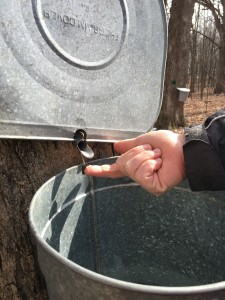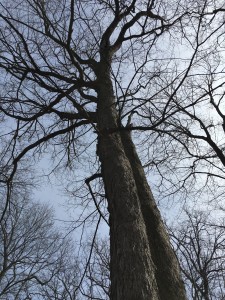McHenry County festival celebrates making of maple syrup
Adela Crandell Durkee For Chronicle Media — March 15, 2016
How sap becomes syrup: Sugaring process. It takes 40 gallons of sap to make one gallon of syrup. (Photo by Adela Crandell Durkee/for Chronicle Media)
McHenry County Conservation District held its annual Festival of the Sugar Maples at Coral Woods.
Each day, more than 200 visitors walked through the forest of sugar maples, witnessed re-enactments of early settlers and native Americans, and learned how to make maple syrup from tree sap.
Coral Woods is one of the few remaining sugar maple groves in the county. Historians believe and conservationists indicate evidence supports that it was used as a sugar grove dating back 80-100 years ago, to Native American times.
According to its literature, the Conservation District began educating thousands of visitors in 1979. Several schools in the area make annual field trips where students can get a taste of the work and pleasure of harvesting sap and processing maple syrup.
Two volunteers dressed in garb from America’s early days explained that the North American Indians were the first to discover “sinziukwud,” the Algonquin word for maple syrup. They used tomahawks to make V-shaped cuts in the trees, before inserting a reed to act as a spigot, dripping the sap into a leather basket. Legend has it that syrup was discovered by accident when a Native American woman cooked meat in what she thought was water, turned out a particularly delicious maple syrup flavored stew.
Conservation District guide, Shelly Kaplan quizzed a group of 30 visitors.
“How many gallons of sap does it take to make a gallon of syrup?” — Forty.
“How many pounds does a gallon of sap weigh?” — Eight.
Today’s process loops tree-spigots together with blue-tinted plastic tubing, which collects sap into a trough weighing nearly half a ton when filled. Pumps, tanks, and tractors move the syrup to the sugar shack, rather than assigning the task to the children of the village.
Kaplan went on to explain that the ideal time to collect sap is when daytime temperatures are relatively warm and nighttime temperatures are below freezing. That’s because the sun’s warmth signals the trees sap to rise to the buds, while nighttime’s chill sends it back into the roots.
Kaplan explained how to recognize trees that produce sugar-rich sap by branch structure. The four types of maple trees that can be tapped to produce syrup are Sugar Maples (or Hard Maples,) Red Maples (or Swamp Maples,) Silver Maples (or Soft Maples,) Ash Leafed Maples (or Box Elder.) The sap from the Sugar Maple has about 3 percent sugar, while the others have 1-1.5 percent.
Education Program Coordinator, Andy Talley, demonstrated the sugaring operation in the ‘sugar shack.’ Because of the large volume of water needs to cook off, and the high sap boiling temperature (219 degrees Fahrenheit) do-it-yourselfers should boil outside. It takes hours to reach the finishing viscosity. Boiling inside a home could steam the wallpaper off the walls.

Visitors get to taste the free-flowing sap at a collection pail. (Photo by Adela Crandell Durkee/for Chronicle Media)
The hour-long tour moved along the half-mile dirt trail. Coral Woods is 775 acres with 2.8 miles of trails. Located at 7400 Somerset, Marengo, Coral Woods also represents one of only eight oak groves remaining in McHenry County that contains 100 acres or more of continuous oak woodland. The sugar maple grove is the county’s largest and has stood for 80-100 years. Coral Woods is open from Sunrise to Sunset.
— McHenry County festival celebrates making of maple syrup —








